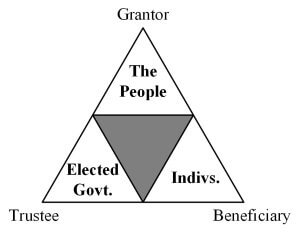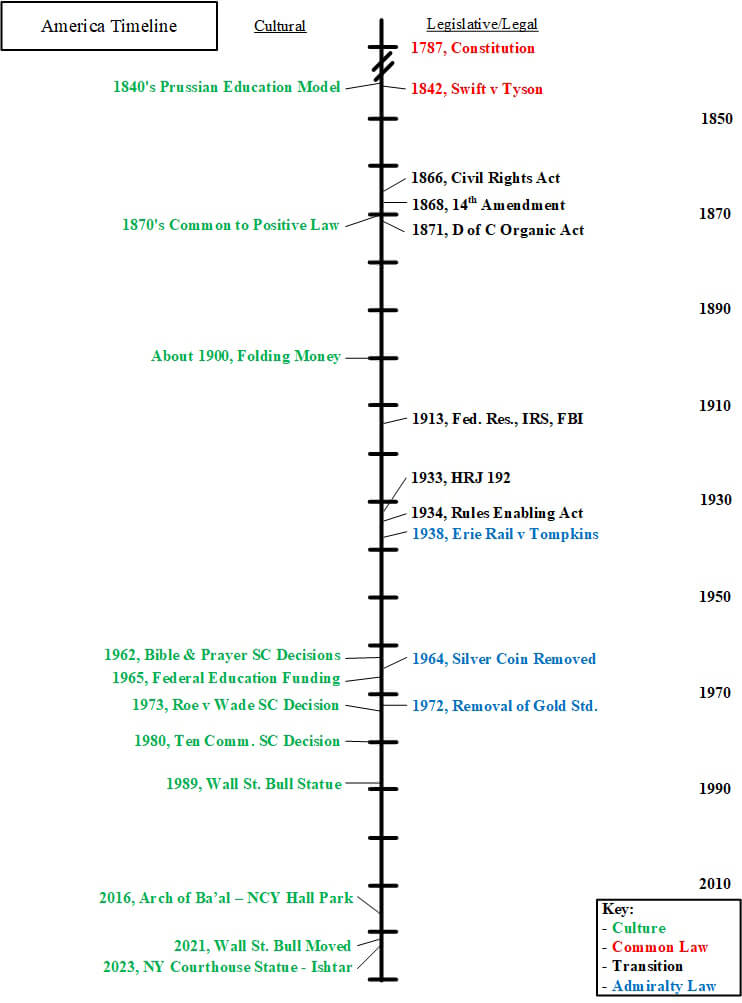We can now put the previous article’s information together to talk about transition. We’ve seen two primary governance models, their ideas, and implications. Next, we looked at America’s foundational documents. These show America’s governance integrated both models. The Biblical model for our private lives; the other primarily for commerce. The people exercised sovereignty through the first; the government through the second. Under the latter, though, the choice was still ours through our unlimited ability to contract in Article I, Section 10. We looked at scriptural prophecies last time, concerning America or a country much like it. You decide. I hope this information makes you consider this subject in a different light.
Today’s topic is no different, and it’s enormous. A matter of where to begin, and how to present the material. The focus is the interrelated areas of; governance, law, and finance. I cover education next time. The presentation is at a high level, so expect some gaps. I’ll provide links where I can, but a number of on-line resources are currently unavailable. Two foundational structures; America as a trust (law), and its bankruptcies (finance) present this material.
America Is a Trust
The first trust appears in Gen. 1:26-8. Here God creates man and woman in His image, granting them dominion over the things of the earth. God, as Creator, is sovereign over everything He creates. Dominion is the lawful granting of authority to another by a sovereign. It conveys a lawful right of use, but creation itself still belongs to God. (see The Two Kingdoms Revisited)
All trusts have three parties; Grantor, Trustee(s), and Beneficiary(s). Grantors create a trust by placing property into trust for another’s benefit. In this case, God granted man lawful use of the things of the earth, but not the earth itself. Trustees are responsible for complying with a trust’s terms and conditions, as outlined in an indenture agreement. We create these agreements either verbally, in writing, or by our actions. This trust’s indenture is the Bible. It outlines God’s requirements and compliance benefits. (Deut. 30:15-8) We are this trust’s trustees and beneficiaries. First, through a people (the Hebrews), and now by our voluntary entry into covenant with God.
A trust diagram follows;

America’s Trust
America used this same trust model. Dominion is lawfully granted authority. Within the Biblical model the people are sovereign. They in turn grant authority over specific items to those they select as leaders. America’s trust looks as follows;

We see this in our state constitutions. All of them within their first one or two articles contain the following; the people have inherent rights, they are the source of sovereignty, and government officials are trustees. Virginia’s constitution is no exception.
“1. THAT all men are by nature equally free and independent, and have certain inherent rights, of which, when they enter into a state of society, they cannot, by any compact, deprive or divest their posterity; . . .
‘2. That all power is vested in, and consequently derived from, the people; that magistrates are their trustees and servants, and at all times amenable to them.
‘3. That government is, or ought to be, instituted for the common benefit, protection, and security, of the people, nation, or community,”[1]
One cannot be a trustee unless there is a trust. The people’s sovereignty derives from common law, and is supported by court opinions.[2] Trust law requires trusts be voluntarily renewed at least every 70 years, or the trust expires. We see this principle applied in the next section.
Our Government’s Bankruptcies
America has been bankrupt at least five times. In addition, it has defaulted on its debt several times. This section looks briefly at each bankruptcy, and one of the defaults. We’ll see America changed each time. There is a pattern and relationship between war, inability to pay debt, and governance changes.
Bankruptcy of 1791
America defaulted on notes held by King George related to the War for Independence and prior debts. This bankruptcy occurred about the same time the Constitution’s Bill of Rights was ratified. Out of this reorganization came America’s first national bank, and the Coinage Act of 1792.[3] The latter established the dollar and minting of gold, silver, and copper coins. This national bank expired when Congress did not renew its charter in 1811; one reason for the War of 1812.
One additional side note, Congress chartered the Second National Bank in 1816, a short time after the war’s treaty signing. It’s charter was not renewed under Andrew Jackson, and this second national bank closed in 1834. So, who won the war?
Bankruptcy of 1861
America’s debt was not yet settled, so it defaulted once again. March of this year marked the final events leading to the War Between the States. This war was initially fought over economic issues including trade, tariffs, and other taxation. Slavery was added during the war as a moral issue. The previous article also mentioned a few international aspects of this war.
Several representatives and senators resigned their seats in March, 1861. Others were expelled. The resulting congress no longer had a quorum to continue its Constitutional functions. On April 15, 1861, Abraham Lincoln issued Presidential Proclamation 80. This proclamation called congress into executive session under Article II, Section 3. These executive sessions only gave Congress the power to make decisions keeping the federal government operational until the war was resolved, constitutional officers elected once again, and the republic reconvened.
Those events never occurred. Lincoln died exactly four years later on April 15, 1865; just a few days after the war’s end. Congress passed two national banking acts during this time. The first in 1863, and a second after Lincoln’s death in 1864.[4] During the war, banks offered the north loans with interest rates of 24 to 36 percent. In response, Lincoln convinced congress to authorize printing treasury notes as full legal tender. These ‘greenbacks’ successfully financed the war. Finally, the federal government incorporated under the District of Columbia Organic Act of 1871 a few years later. This act created a federal government corporation under congress’ control within the federal district.[5] Today all federal agencies, bureaus, departments are government corporations, as are all states and almost all counties.[6]
Default of 1912
The new corporate government began generating debt, issuing bonds due in 1912. The corporate government was unable to make payment on the debt. In 1913 the Federal Reserve Bank (the fourth national bank), IRS, and FBI were all created. The XVth Amendment ensuring U.S. citizen’s right to vote, and the XVIth Amendment giving Congress the power to lay and collect taxes on income were also ratified that same year.
Bankruptcy of 1931
At this point, settling debts still required the use of gold or silver, as per the Constitution under Article 1, Sections 7 and 8. The market collapse of 1929 put the country into a deep economic depression. The United States could not pay its debts. Franklin Roosevelt signed The Emergency Banking Act on March 9, 1933, using provisions from the 1917 Trading with the Enemies Act. Shortly after, Roosevelt made it illegal to withdraw, export, or hold gold or gold certificates (currency) through Executive Orders 6073,[7] 6102,[8] 6111[9] and 6260[10]—with certain limited exceptions.
Congress issued House Joint Resolution 192 on June 5. It stated the “right to require payment in gold or a particular kind of coin or currency, . . . is declared to be against public policy . . . Every obligation, . . . shall be discharged upon payment, dollar for dollar, in any coin or currency which at the time of payment is legal tender for public and private debts.”[11] At almost the same time, the government issued Federal Reserve Notes (FRNs) as legal tender. These notes are currency, not money. Currency is a money substitute. Further, FRNs are not secured by gold or silver.[12]
Other Actions
A number of relevant actions occurred in the next seven years before World War II. These played a key role in transforming America from a republic into a democracy, and moving sovereignty from the people to government. These include;
- Rules Enabling Act of 1934 – Congress granted the supreme court the ability to create judicial rules for trying cases. The Rules of Civil Procedure came out of this act.
- Social Security Act (1935) – Enabled by the Sheppard-Towner Maternity Act of 1921 creating birth registrations. This act created a public trust and trusts for each registered individual. Such trust accounts are necessary as FRNs are debt—United States obligations.[13] FRNS cannot settle debt; they only represent a mutual agreement to defer settlement.
- Rules of Civil Procedure (1938) – Rules merging equity and common law into one single administrative process based upon (Roman) civil, or Admiralty, law.
- Erie Rail v. Tompkins (1938) – Supreme court case ending use of common law by federal courts.
- Buck Act (1940) – Created federal zone fictions mirroring each state.
From the Congressional Record
America never left this bankruptcy. A March 17, 1993 Congressional Record excerpt by Rep. Traficant (OH) stated, “Mr. Speaker, we are here now in chapter 11 [bankruptcy]. Members of Congress are official trustees presiding over the greatest reorganization of any bankrupt entity in world history, the U.S. government. We are setting forth hopefully a blueprint for our future. There are some who say it is a coroner’s report that will lead to our demise.”[14]
Bankruptcy of 2001
On September 10, 2001, Dept. of Defense Secretary Rumsfeld announced that $2.3 trillion in Pentagon funds could not be traced. No one knew where the money went. We do know what happened the following day.
But it gets worse. A project undertaken by Dr. Mark Skidmore of Michigan State University and Catherine Austin Fitts[15] suggests the Departments of Defense and Housing and Urban Development alone had $21 trillion in unsupported journal transactions between 1998 and 2015.[16]
Bankruptcy of 2011
On September 11, 2011, “President Barack Obama made the stunning announcement to the General Assembly of the United Nations that the United States was filing for bankruptcy.”[17]
From A Republic to Democracy
America’s government changed over several hundred years. Law and finance changes transformed government itself. We reached a tipping point in the 1930’s. F. Roosevelt’s banking emergency declaration is still in effect today. The declaration gave the federal government broad powers to address the emergency. The changes in currency, basis of law, process of law, congressional acts, and executive orders allowed the people to unknowingly contract themselves out from under the Constitution. That is no different today.
A Senate special committee issued a report on terminating the national emergency in 1993. Its forward says in part, “Since March 9, 1933, the United States has been in a state of declared national emergency. In fact, there are now in effect four presidentially-proclaimed states of national emergency: in addition to the national emergency declared by President Roosevelt in 1933, . . .
‘These proclamations give force to 470 provisions of Federal law. These hundreds of statutes delegate to the President extraordinary powers, ordinarily exercised by the Congress, which affect the lives of American citizens in a host of all-encompassing manners. This vast range of powers, taken together, confer enough authority to rule the country without reference to normal Constitutional processes.”[18] Creating an administrative state, using legal constructs like the Chevron doctrine, amplified this shift. The supreme court recently overturned this doctrine’s use.[19] Some officials today speak of certain changes destroying our democracy. They will, and that is a good thing.
The next time we will move to critical theory and some American education changes. Below is a timeline referencing some article events and related items.

Footnotes:
[1] Library of Virginia, Virginia Constitutions, https://www.lva.virginia.gov/constitutions/. Accessed Oct., 2024.
[2] For more, see footnote 8 in Is America a Christian Nation?. https://vachristian.org/is-america-a-christian-nation/
[3] Federal Reserve, The First Bank of the United States, https://www.federalreservehistory.org/essays/first-bank-of-the-us. Accessed October, 2024. This sites articles convey a central bank perspective, rather than a Constitutional one.
[4] Federal Reserve, National Banking Acts of 1863 and 1864, https://www.federalreservehistory.org/essays/national-banking-acts . Accessed Oct., 2024.
[5] See 28 USC §3002(15)(A), “United States means—(A) a Federal corporation;”
[6] Kosar, Kevin R., Federal Government Corporations: An Overview, Congressional Research Service, June 8, 2011. Note this document only cites 17 government corporations, but at the time there were many more. Today there were over 66,000 as of spring of 2023.
[7] University of California Santa Barbara, The American Presidency Project, Executive Order 6073—Reopening Banks, https://www.presidency.ucsb.edu/documents/executive-order-6073-reopening-banks . Accessed Oct., 2024.
[8] University of California Santa Barbara, The American Presidency Project, Executive Order 6102—Forbidding the Hoarding of Gold Coin, Gold Bullion and Gold Certificates, https://www.presidency.ucsb.edu/documents/executive-order-6102-forbidding-the-hoarding-gold-coin-gold-bullion-and-gold-certificates . Accessed Oct., 2024.
[9] University of California Santa Barbara, The American Presidency Project, Executive Order 6111—Relating to Foreign Exchange and the Earmarking and Export of Gold coin or Bullion or Currency, https://www.presidency.ucsb.edu/documents/executive-order-6111-relating-foreign-exchange-and-the-earmarking-and-export-gold-coin-or . Accessed Oct., 2024.
[10] University of California Santa Barbara, The American Presidency Project, Executive Order 6260—Relating to the Hoarding, Export, and Earmarking of Gold Coin, Bullion, or Currency and to Transactions in Foreign Exchange, https://www.presidency.ucsb.edu/documents/executive-order-6260-relating-the-hoarding-export-and-earmarking-gold-coin-bullion-or . Accessed Oct., 2024
[11] The Statutes at Large, pp. 112-3, Vol. XLVIII, part 1, United States Govt. Printing Office, 1934.
[12] For more information on this subject, see; Brobst, Lee, The Law, The Money, and Your Choice, https://constitutionwatch.com.au/wp-content/uploads/The-Law-Money-and-Your-Choice-by-Lee-Brobst.pdf .
[13] See 18 USC §8. “[O]bligations or other security of the United States includes . . . Federal Reserve bank notes.”
[14] Congressional Record—House, Volume 139, Part 4, March 17, 1993, p. 5321. Accessed Oct. 2024.
[15] Skidmore, Mark and Fitts, Catherine Austin, Summary Report on ‘Unsupported Journal Voucher Adjustments’ in the Financial Statements of the Office of the Inspector General for the Department of Defense and the Department of Housing and Urban Development, https://missingmoney.solari.com/wp-content/uploads/2018/08/Unsupported_Adjustments_Report_Final_4.pdf . Accessed Oct., 2024.
[16] Fitts, Catherine Austin, DOD and HUD Missing Money: Supporting Documentation for $21 Trillion of Undocumentable Adjustments, The Solari Report, Oct. 2, 2017, https://home.solari.com/dod-and-hud-missing-money-supporting-documentation/ . Accessed Oct., 2024.
[17] Fast Company Newsletter, U.S. Declares Bankruptcy!, July 25, 2011, https://www.fastcompany.com/1768870/us-declares-bankruptcy . Accessed Oct., 2024.
[18] Senate, Special Committee on the Termination of the National Emergency, Report of the Special Committee on the Termination of the National Emergency, U.S. Government Printing Office, November 19, 1973.
[19] Loper Bright Enterprises v. Raimondo, https://www.supremecourt.gov/opinions/23pdf/22-451_7m58.pdf . Accessed Oct., 2024.




